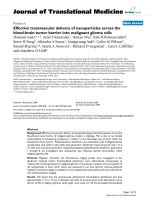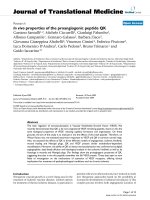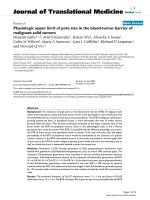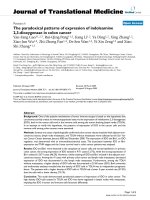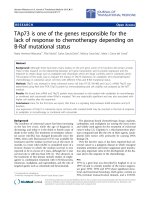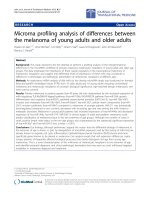báo cáo hóa học:" The intra-articular use of ropivacaine for the control of post knee arthroscopy pain" doc
Bạn đang xem bản rút gọn của tài liệu. Xem và tải ngay bản đầy đủ của tài liệu tại đây (200.72 KB, 4 trang )
BioMed Central
Page 1 of 4
(page number not for citation purposes)
Journal of Orthopaedic Surgery and
Research
Open Access
Research article
The intra-articular use of ropivacaine for the control of post knee
arthroscopy pain
Efthimios P Samoladas*, Byron Chalidis, Hlias Fotiadis, Ioanis Terzidis,
Thomas Ntobas and Miltos Koimtzis
Address: Orthopaedic Department, Veria Hospital, Greece
Email: Efthimios P Samoladas* - ; Byron Chalidis - ; Hlias Fotiadis - ;
Ioanis Terzidis - ; Thomas Ntobas - ; Miltos Koimtzis -
* Corresponding author
Abstract
Aims: The purpose of this prospective randomised study is to evaluate the efficacy, safety and
the appropriate dose of the ropivacaine in the control of post-knee arthroscopy pain.
Methods: We randomised 60 patients in two groups to receive 10 ml/7.5 mg/ml ropivacaine
(Group B) or 20 ml/7.5 mg/ml (Group A) at the end of a routine knee arthroscopy. We
monitored the patient's blood pressure, heart rate, allergic reactions, headache, nausea, we
assessed the pain using the visual analogue score at intervals of 1,2,3,4 and 6 hours after the
operation. and we recorded the need for extra analgesia.
Results: The intraarticular use of the ropivacaine provided excellent control of pain after knee
arthroscopy. At two hours post-operatively there wasn't any difference between the two
groups. Afterwards, the Group A showed increased pain and need for supplementary
medication.
Conclusion: We believe that intraarticular use of ropivacaine is effective to reduce post-
operative pain minimising the use of systematic analgesia.
Background
Arthroscopic knee surgery is one of the most common sur-
gical procedures done in an outpatient setting. Post oper-
ative pain undoubtedly, it has a negative impact on the
patient's psychology causing discomfort and prohibiting
early mobilisation.
Administration of oral opioids and non-steroid antin-
flammatory drugs are combined with sufficient relief of
pain in the immediate postoperative period [9]. However,
they aren't site-specific and can be burdened by side
effects, such as respiratory depression, nausea or acute gas-
tric lesions, Early post operative pain following arhro-
scopic knee surgery is well controled with the use of a
local anaesthetic agent. This has confirmed in many con-
trolled studies [1,2].
Although the pain has been reported slight to moderate
and of short duration, a review of 20 studies showed evi-
dence for reduction in postoperative pain after intra-artic-
ular local anaesthesia following arthroscopic knee surgery
[3]. No adverse effects or toxicity attributable to the intra-
articular administration of local anaesthetics were
reported in this review [4].
Published: 23 December 2006
Journal of Orthopaedic Surgery and Research 2006, 1:17 doi:10.1186/1749-799X-1-17
Received: 11 March 2006
Accepted: 23 December 2006
This article is available from: />© 2006 Samoladas et al; licensee BioMed Central Ltd.
This is an Open Access article distributed under the terms of the Creative Commons Attribution License ( />),
which permits unrestricted use, distribution, and reproduction in any medium, provided the original work is properly cited.
Journal of Orthopaedic Surgery and Research 2006, 1:17 />Page 2 of 4
(page number not for citation purposes)
Ropivacaine is a new local amino-amide anesthetic that
blocks peripheral afferents from acting on voltage-
dependent Na
+
channels. It has the similar pharmacoki-
netic properties as bupivacaine but different pharmacody-
namic such as their vasodilatory property and the toxicity.
Furthermore, ropivacaine has a lower molecular weight
than bupivacaine (Ropi 262 vs Bupi 288) The chance to
use this drug in high concentrations provides higher clin-
ical efficacy [5]. The purpose of this study was to compare
the analgesic efficacy of ropivacaine 7,5 mg/ml in post
knee arthroscopy pain. We test whether 20 ml of 7,5 mg/
ml ropivacaine gives better analgesia than 10 ml of 7,5
mg/ml ropivacaine.
Patients and methods
After the approval of local scientific committee and signed
informed consent, 60 patients (45 males and 15 females)
with mean age of 33 years (range 19–50 years) and ASA I-
II(American Society of Anesthesiologists) physical status,
were scheduled for a routine elective knee arthroscopy.
Patients with a history of sensitivity to local anaesthetics
or preoperative administration of opioids or any other
analgesics in the preceding 48 h were excluded from the
study. Surgical interventions were diagnostic arthroscop-
ies, meniscal excision or repair, removal of loose bodies
and arthroscopic debridement. Cases of extensive arthro-
scopic synovectomy, ligament reconstruction and articu-
lar cartilage procedures were excluded.
All the arthroscopies were performed under tourniquet
application and by the same surgeon. Two standard por-
tals (anteromedial and anterolateral) were used and the
mean duration of the whole procedure was 45 min (range
35 to 60 min).
Standardised general anaesthesia was selected in all the
cases. Muscle relaxants and short-acting opioids (fenta-
nyl) were used at the beginning of the operation. No non-
steroidal anti-inflammatory drugs or additional pain
medications were administered.
Patients were divided in two groups of 30 patients in each
group using randomly sealed envelopes. Group B patients
received ropivacaine 10 ml of 7,5 mg/ml and Group A
patients received ropivacaine 20 ml of 7.5 mg/ml at the
end of surgery.
At the postoperative period we record the heart rate, blood
pressure, allergic reactions, nausea and headache for the
first 6 hours. Visual Analogue Score (VAS) for pain scores
was recorded at intervals of 1, 2, 3, 4 and 6 h after the
intra-articular injection.
In case of need of supplementary analgesics, 1 g paraceta-
mole plus codeine phosphate 60 mg was administered. In
the event that there was no pain relief, 75 mg i.m diclo-
phenac was injected. The time to the first request for anal-
gesia and the total analgesic requirements were recorded.
The data were analysed using T-test for VAS and Chi-
square test for analgesic consumption.
Results
No statistical difference regarding the VAS at the first 2
hours was detected between the two groups. At 3 hours
post-operatively there was statistically lower VAS in Group
A than in Group B (fig 1). After that time and if required,
additional analgesia was admitted. At 4 and 6 hours post-
operatively the VAS didn't show any difference but the
result was affected by the potential use of supplementary
analgesics.
As mentioned above none of the patients required extra
analgesia until 3 hours post-operatively. Afterwards,
Group B used significantly more analgesics than Group A.
(p < 0,5).
No adverse reaction has been recorded between the
groups.
Discussion
Many modes of postoperative analgesia have been
reported for patients undergoing knee arthroscopy [8].
The use of opioid drugs, administered by means of either
patient-controlled analgesia or other methods, deals with
postoperative pain efficiently but is often associated with
side effects, including nausea and vomiting, respiratory
depression, drowsiness, pruritus, reduced gut motility,
and urinary retention [7]. Providing analgesia locally is an
attractive option with minimal systemic side effects, and
may lead to an earlier discharge from the hospital. Intraar-
ticular drug administration is one of the simplest tech-
The comparison of VAS values of the groups at 1,2,3 hoursFigure 1
The comparison of VAS values of the groups at 1,2,3 hours.
1,9
2,2
2,1
2,7
1,58
1.61
0
1
2
3
4
5
1h 2h 3h
TIME
VAS
Group A
Group B
Journal of Orthopaedic Surgery and Research 2006, 1:17 />Page 3 of 4
(page number not for citation purposes)
niques requiring no specialised equipment for pain
management after arthroscopic knee surgery [11].
Ropivacaine is a commonly used local anaesthetic and it
is related structurally to bupivacaine and mepivacaine. It
is a less lipid soluble than bupivacaine, but its pharma-
cokinetic disposition is similar. Ropivacaine seemed to
provide similar and effective post-arthroscopy analgesia
[6] compared to bupivacaine, showing less Central Nerv-
ous System (CNS) and cardiac toxicity [6].
Plasma concentrations of ropivacaine has been studied by
Convery et al [4] and they found that for all patients and
all doses (100–200 mg) fell below the estimated toxic
thresholds, and therefore it seems that ropivacaine can be
safely administered by intra-articular injection. Further-
more, Francesco et al reported that intra-articular admin-
istration of ropivacaine is as effective as morphine in
controlling pain during the first 24 hours after knee
arthroscopy, but it has an earlier onset than morphine [7].
The acute and most serious adverse effects of local anes-
thetics involve the CNS and the cardiovascular system.
They usually occur either because of accidental intravascu-
lar or intrathecal injections, or a pronounced overdose.
CNS symptoms of local anesthetic toxicity occur before
cardiovascular symptoms and signs, and include numb-
ness of the tongue, light-headedness, visual disturbances,
and muscular twitching; more serious signs include sei-
zures, coma, respiratory arrest, and cardiovascular depres-
sion. Extremely high concentrations depress spontaneous
pacemaker activity in the sinus node and result in sinus
bradycardia and sinus arrest. In our study none of the
patients developed any adverse reactions therefore we
assume that intraarticular dose of ropivacaine up to 150
mg is safe.
Our results revealed that there is no difference in pain
between 10 ml and 20 ml of 7,5 mg/ml, at 2 hours post-
operatively. At 3 hours there was a statistical difference in
VAS and this was also confirmed by the use of supplemen-
tary analgesia.
After arthroscopy, acute inflammation is induced by the
release of mediators from damaged cells. Martin et al
noted that cryotherapy works in the acute inflammatory
response decreasing the narcotic consumption, pain and
knee swelling [10]. Although we didn't use cold therapy in
our cases, we believe that the promising results of cryocuff
application necessitates its use after knee arthroscopy pro-
cedures.
As a conclusion, intraarticular injections of local anaes-
thetics seems to provide an alternative and effective solu-
tion in pain control after knee arthroscopy.
Table 3: Number of patients requiring extra analgesia
EXTRA DRUG 3RD EXTRA DRUG 4TH EXTRA DRUG 6TH EXTRA DRUG
OVERAL
GROUP A 36918
GROUP B 10 7 8 25
Table 1: Group A Number of patients and VAS
VAS 1H2H3H4H6H
1 1817151311
2 77766
3 56566
4 334
513
6
7
81
9
10
Table 2: Group B Number of patients and VAS
VAS 1H2H3H4H6H
1 1713111212
2 76565
3 66555
4 3454
5 1324
6
71
811
Publish with BioMed Central and every
scientist can read your work free of charge
"BioMed Central will be the most significant development for
disseminating the results of biomedical research in our lifetime."
Sir Paul Nurse, Cancer Research UK
Your research papers will be:
available free of charge to the entire biomedical community
peer reviewed and published immediately upon acceptance
cited in PubMed and archived on PubMed Central
yours — you keep the copyright
Submit your manuscript here:
/>BioMedcentral
Journal of Orthopaedic Surgery and Research 2006, 1:17 />Page 4 of 4
(page number not for citation purposes)
References
1. Chirwa SS, MacLeod BA, Day B: Intra-articular bupivacaine
(Marcaine) after arthroscopic meniscectomy: a randomized
double-blind controlled study. Arthroscopy 1989, 5:352.
2. Geutens G, Hambridge JE: Analgesic effects of intra-articular
bupivacaine after day-case arthroscopy. Arthroscopy 1994,
10:299-300.
3. Moiniche S, Mikkelsen S, Wetterslev J, Dahl JB: A systematic
review of intra-articular local anesthesia for postoperative
pain relief after arthroscopic knee surgery. Reg Anesth Pain Med
1999, 24:430-7.
4. Convery PN, Milligan KR, Quinn P, Sjövall J, Gustafsson U: Efficacy
and uptake of ropivacaine and bupivacaine after single intra-
articular injection in the knee joint. British Journal of Anaesthesia
2001, 87(No. 4):570-576.
5. Wolff AP, Hasselstrom L, Kerkkamp HE, Gielen MJ: Extradural rop-
ivacaine and bupivacaine in hip surgery. Br J Anaesth 1995,
74:458-460.
6. Scott DB, Lee A, Fagan D, Bowler GMR, Bloomfield P, Lundh R:
Acute toxicity of ropivacaine compared with that of bupi-
vacaine. Anesth Analg 1989, 69:563-569.
7. Franceschi Francesco, Rizzello Giacomo, Cataldo Rita, Denaro Vin-
cenzo: Comparison of morphine and ropivacaine following
knee arthroscopy. Arthroscopy 2001, 17(No 5):477-480.
8. Allen GC, St Amand MA, Lui AC, Johnson DH, Lindsay MP: Postar-
throscopy analgesia with intraarticular bupivacaine/mor-
phine. A randomized clinical trial. Anesthesiology 1993,
79:475-80.
9. Tsai L, Wredmark T: Arthroscopic surgery of the knee in local
anaesthesia. An analysis of age-related pathology. Arch Orthop
Trauma Surg 1993, 112(3):136-8.
10. Martin , Stephanie S, Spindler , Kurt P, Tarter , Jeremy W, Detwiler ,
Ken B: Does Cryotherapy Affect Intraarticular Temperature
After Knee Arthroscopy? Clinical Orthopaedics and Related
Research 2002, 400:184-189.
11. Talu G, Ozyalcin S, Kolta K, Erturk E, Akincin O, Asik M, Pembeci K:
Comparison of efficacy of intraarticular application of tenox-
icam: bupivacaine combination inarthroscopic knee surgery.
Knee Surg Sports Traumatol 2002, 10:355-360.

